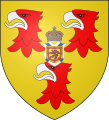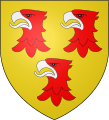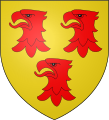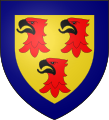Clan Nicolson facts for kids
Quick facts for kids Clan Nicolson |
|
|---|---|
| MacNeacail | |
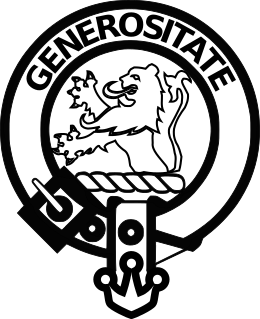 |
|
| Motto | Generositate (By generosity) |
| Profile | |
| Plant badge | Sprig of juniper |
| Chief | |
 |
|
| Adam Nicolson, 5th Baron Carnock | |
| 5th Baron Carnock | |
Clan Nicolson is a Scottish clan from the Lowlands. A "clan" is like a big family group with a shared history. This clan believes its family line started with a lawyer in Edinburgh in the 1500s. Before him, there were important merchants from Aberdeen in their family history.
In the 1980s, David Nicolson, 4th Baron Carnock was officially recognized as the chief of Clan Nicolson. This recognition came from the Lord Lyon King of Arms, who is in charge of Scottish heraldry and clans.
At the same time, another person named Nicolson, who was from a different Highland family on the Isle of Skye, also wanted to be recognized as a clan chief. The Lord Lyon King of Arms agreed, but only if he changed his last name to MacNeacail. This is why there are two Scottish clans with similar names: the Lowland Clan Nicolson and the Highland Clan MacNeacail.
Contents
History of Clan Nicolson
What Does the Name Nicolson Mean?
The last name Nicolson means "son of Nicol". The name Nicol comes from a word meaning "victory people".
Interestingly, two Scottish clans share this name: the Lowland Clan Nicolson and the unrelated Clan MacNeacail from Skye. This happened because, in the late 1600s, some members of Clan MacNeacail started to change their Gaelic name to Nicolson.
Where Did the Clan Come From?
The symbols of Clan Nicolson and Clan MacNeacail look similar. Both clan chiefs have a gold shield with birds of prey. The Nicolsons have falcons, and the MacNeacails have hawks. However, there isn't much proof that the chiefs of these two clans are actually related by family.
The name Nicolson can also be found in places like Tyneside and Yorkshire in England. This is because the Norse people, who were Vikings, raided many places around the coast of Scotland and northern England.
The Scottish-Norwegian War
During the Scottish–Norwegian War, the last Norse king to invade Scotland was Haakon IV of Norway. He sent a group led by Anders Nicolassen to attack the Isle of Bute. Anders was the king's foster brother and an important leader.
After this, they joined the main Norse fleet near Largs. The Norsemen lost the Battle of Largs. But there's a story that Anders Nicolassen stayed in Scotland. He was sent from Norway to help make the Treaty of Perth. This treaty officially gave the Scottish king control of the islands that Norway used to rule.
The 1500s and 1600s
The main family line of Clan Nicolson started with James Nicolson, a lawyer in Edinburgh. He passed away around 1580. His family had been important merchants in Aberdeen in the 1400s.
James had two sons, John and James. James became a church leader and was made Bishop of Dunkeld in 1606. He died in 1607.
John, James's older brother, bought land in Lasswade in 1592. In 1629, John's son was given a special title called a Baronet in Nova Scotia. This title was for "Nicolson of that Ilk and Lasswade". His grandson later became a representative for Edinburgh in Parliament in 1672.
The 1800s
The direct male line of the clan chiefs ended by 1826. Other family members, who were descendants of Bishop James Nicolson, then claimed the titles.
The title Baron of Carnock went to Major General Sir William Nicolson. He was the only son of George Nicolson of Tarviston. General Nicolson served in the Americas, India, Ireland, and Mauritius. He died in 1820.
His son, Admiral Sir Frederick Nicolson, took over the title. In 1879, the admiral's oldest son, Frederick, was killed fighting the Zulus. So, the title went to the second son, Arthur, in 1899. In June 1916, Arthur was given the new title of Baron Carnock of Carnock.
In the 1980s, David Nicolson, 4th Baron Carnock asked the Lord Lyon King of Arms to recognize him as the chief of Clan Nicolson. This was because his ancestor was John Nicolson, the 1st Baronet of Lasswade. At the same time, another Nicolson was trying to become chief of the Highland Nicolsons.
In 1985, David Nicolson, 4th Baron Carnock, was officially recognized as the chief of the name Nicolson. The position of chief of Clan Nicolson is currently empty. However, Adam Nicolson, 5th Lord Carnock, could rightfully claim it.
Heraldry
Today, members of Clan Nicolson can show they belong to the clan by wearing a Scottish crest badge. This badge has the chief's special symbol, called a heraldic crest, and a saying, called a heraldic motto.
The motto on the badge is GENEROSITATE. This Latin word can mean "by generosity" or "by inheritance". The crest itself shows a golden lion coming out, with red claws and tongue. These symbols on the crest badge come from the official symbols of Nicolson of that Ilk.
The symbols for the chiefs of Clan Nicolson and Clan MacNeacail are very similar. In fact, the symbols of the MacNeacail chief are a bit less important than those used by the Nicolson chief.
See also
- Baron Carnock
- Nicolson Baronets
- Clan MacNeacail, the Highland "Nicolsons" historically centred on the Isle of Skye.


